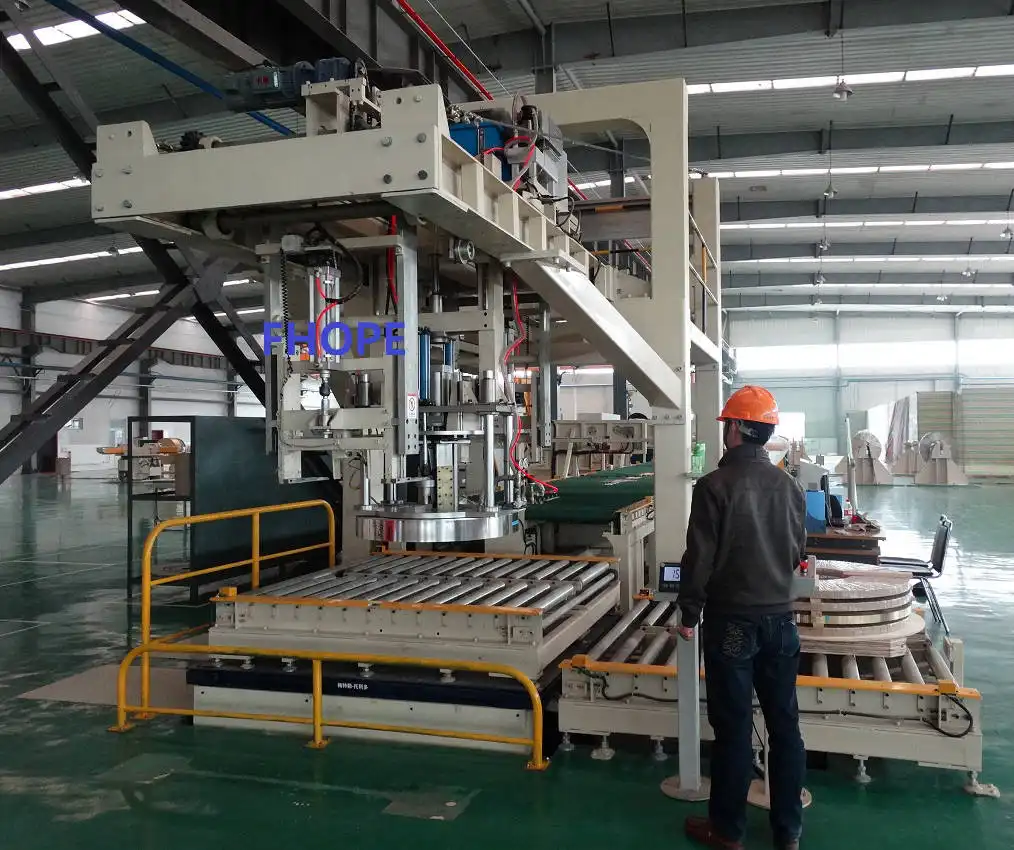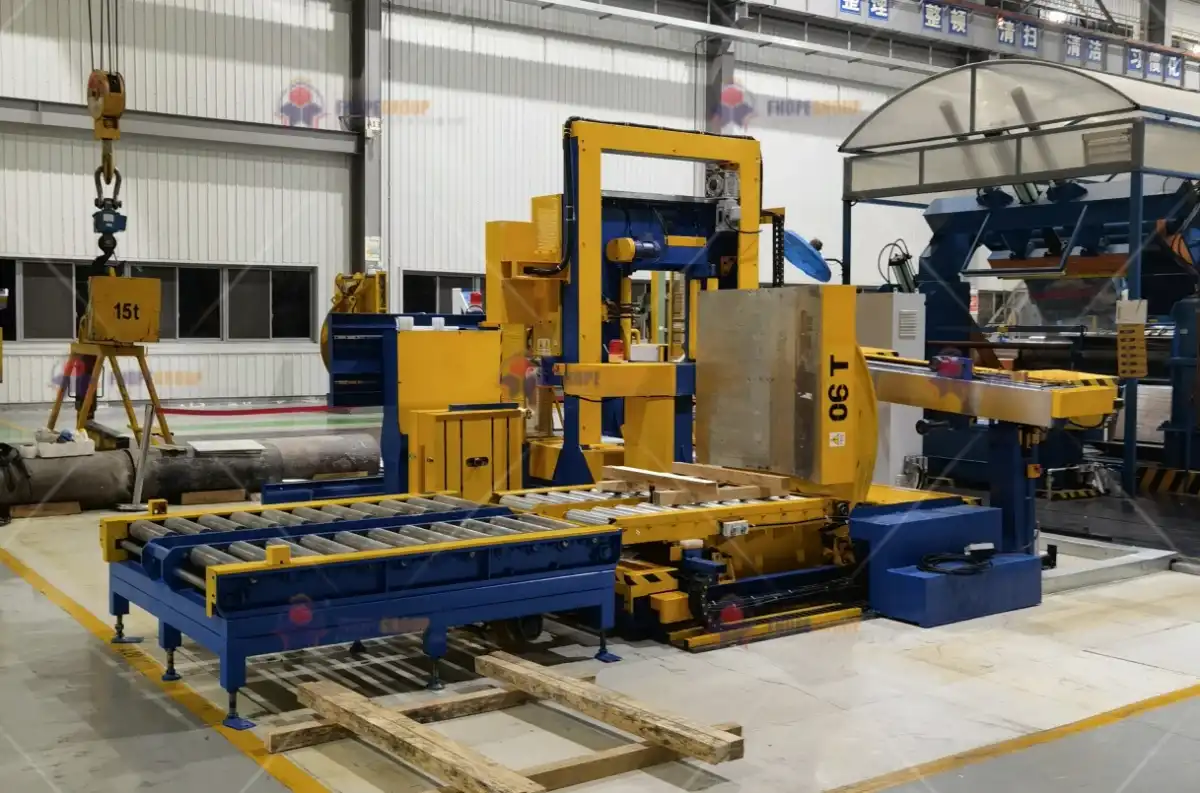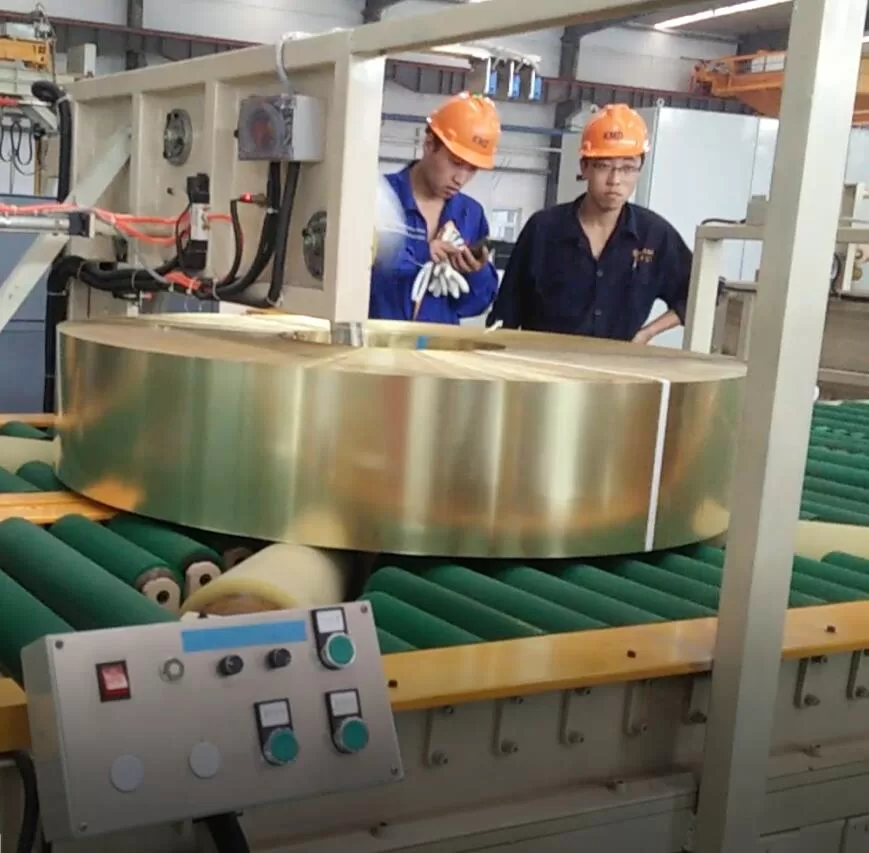Running a steel mill in Spain today is a balancing act. You're facing volatile energy prices that can change your entire cost structure overnight. At the same time, older equipment on the factory floor is becoming less reliable, causing unexpected stops in production. These issues directly threaten your profitability and make it hard to plan for the future. But what if you could turn a major cost center—your packing line—into a source of savings and efficiency? Investing in a modern, energy-efficient steel coil packing solution is not just another expense; it's a strategic move to secure your return on investment and build a more resilient business.
To maximize ROI, steel mills in Spain should adopt energy-efficient steel coil packing lines that directly lower electricity consumption with modern servo motors and smart power-saving modes. These systems also reduce material waste and integrate with factory-wide digital platforms. This combination leads to higher uptime, decreased operational costs, and a significant boost to your bottom line.

I've walked the floors of countless steel mills, first as an engineer and later as a factory owner myself. I understand the pressure you're under. You need every piece of equipment to contribute to your success. A packing line might seem like the end of the process, but it holds incredible potential for savings and efficiency gains. It's a critical point where you can protect your product, your profits, and your production schedule. Let's explore how a carefully chosen packing line solution can help you overcome your biggest challenges and achieve your goals.
How Can an Upgraded Packing Line Tackle Spain's Rising Energy Costs?
You see the electricity bills. They are unpredictable and keep climbing, eating away at your margins. This makes it difficult to forecast costs and commit to long-term pricing for your customers. You feel like you're fighting a battle you can't win against market forces. The solution lies in taking control of what you can: the energy consumption inside your own plant. A modern packing line is engineered with this exact challenge in mind.
An upgraded packing line directly tackles Spain's rising energy costs by using high-efficiency motors, intelligent power-saving modes, and optimized wrapping processes. These features work together to consume significantly less electricity and wrapping material for every steel coil you package, leading to immediate and measurable savings.

Deeper Dive: Pinpointing Energy Savings
When I started my own factory, I analyzed every single machine's power consumption. The older hydraulic systems were some of the worst offenders. They run a pump continuously, even when the machine is idle between coils. This is like leaving a car engine running at a red light. It's pure waste. Today’s technology offers a much smarter way.
From Hydraulic to All-Electric
The biggest leap in energy efficiency comes from replacing old hydraulic power packs with modern servo-electric systems. A servo motor only uses significant power when it needs to perform an action, like rotating the coil or moving the shuttle. During idle times, its energy consumption drops to almost zero. This "on-demand" power usage can cut the energy consumption of your packing machine’s main movements by up to 70%. Think about the cumulative savings over thousands of operating hours per year.
The Power of VFDs
Another key component is the Variable Frequency Drive (VFD). In older machines, motors run at a single, constant speed. VFDs allow us to precisely control the speed of motors for conveyors and rollers. We can soft-start them to avoid power spikes and run them at the optimal speed for the task, rather than full blast all the time. This not only saves energy but also reduces mechanical wear and tear on the equipment, extending its life.
Let’s look at a simple comparison:
| Component Feature | Old Packing Line (15+ years) | Modern Energy-Efficient Line | Direct Impact on Your Mill in Spain |
|---|---|---|---|
| Main Drive System | Hydraulic power pack | All-electric servo motors | Reduces idle energy waste by over 90%. |
| Motor Control | Direct-on-line starters | Variable Frequency Drives (VFDs) | Eliminates high inrush current, lowers peak demand charges. |
| Heating Elements | Basic on/off control | PID temperature controllers | Maintains precise temperatures for film sealing, preventing overheating and waste. |
| Idle State | Motors run continuously | Automatic sleep/standby mode | Further cuts power use during production gaps. |
By focusing on these specific technologies, an upgraded packing line becomes a tool for managing your energy costs. In a market like Spain, where energy prices are a major business risk, this level of control is not just a benefit—it’s a competitive advantage.
What's the Real Impact of Aging Packing Equipment on Your Bottom Line?
An old packing line fails, and it always seems to happen at the worst possible time. Production comes to a sudden halt. Your team scrambles to fix the issue, but the clock is ticking. You have trucks waiting and customers expecting their orders. Each minute of downtime costs you money and damages your reputation. You are constantly fighting fires instead of planning for growth. Understanding the full, cascading cost of this aging equipment is the first step to justifying a necessary upgrade.
The real impact of aging packing equipment goes far beyond the cost of spare parts and repairs. The biggest damage to your bottom line comes from lost revenue due to unplanned downtime, reduced throughput from slower cycle times, increased material waste from inconsistent packing, and serious safety hazards for your employees.

Deeper Dive: The Hidden Costs You Don't See on an Invoice
I remember a situation early in my career at a large steel plant. The main packing line went down due to a failed gearbox on a 20-year-old machine. It seemed like a simple component failure. But the consequences were huge. The part was obsolete, and it took three days to have a new one custom-fabricated. For three days, a multi-million-euro production line was bottlenecked. We couldn't ship finished coils, which created a massive backlog and delayed customer deliveries. The financial impact was staggering. This experience taught me that the true cost of old equipment is never just the price of the broken part.
Let's break down these hidden costs, which are directly impacting your profitability.
The True Cost of Downtime
Unplanned downtime isn't just an inconvenience; it's a financial drain. To calculate it, you must consider:
- Lost Production: How many tons of steel could you have processed and shipped? Multiply that by your profit margin per ton.
- Idle Labor: Your operators and logistics staff are paid to be productive. When the line is down, you are paying for them to wait.
- Repair Costs: This includes not just the spare part but also the maintenance team's hours, and potentially expensive overtime or external contractor fees.
Decreased Throughput and Quality Issues
Even when it's running, an old machine is rarely running at its original speed. Wear and tear on mechanical parts, slower control systems, and frequent small adjustments mean you are packing fewer coils per hour than a new machine could. Furthermore, inconsistent wrapping, poor sealing, or improper strap tension can lead to damaged coils during transit. This results in customer complaints, rejected shipments, and costly rework—all of which hurt your bottom line and your brand's reputation.
Here’s a clearer view of how these factors add up:
| Cost Factor | Aging Packing Line | Modern Packing Line | Impact on Your Profitability |
|---|---|---|---|
| Uptime | 80-85% (frequent breakdowns) | 95%+ (predictive maintenance) | Increased shippable output, reliable scheduling. |
| Cycle Time | Slower due to mechanical wear | Optimized for speed and efficiency | Higher throughput, more coils packed per shift. |
| Material Waste | Inconsistent film stretch/application | Precise control, less film/strap used | Direct reduction in consumables cost. |
| Spare Parts | Hard to find, long lead times | Readily available standard parts | Faster repairs, less downtime when issues occur. |
| Safety | Worn guards, oil leaks, outdated safety circuits | Fully compliant with modern safety standards | Reduced risk of accidents and related costs. |
When you look at the complete picture, the decision becomes clear. Continuing to operate an aging packing line is not saving money. It's an ongoing, hidden expense that actively reduces your potential profit every single day.
How Does a Modern Packing Line Integrate with Digital Transformation Goals?
You have a vision for a "smart factory." You want data, visibility, and control over your entire production process. But right now, your packing area might feel like a disconnected island. You can't see its real-time status, you don't know its efficiency, and you can't manage it from your central system. You cannot optimize what you cannot measure, and this data black hole is holding back your entire digital transformation strategy. A modern packing line is designed to solve this problem, acting as a vital data source for your factory's brain.
A modern packing line integrates with your digital transformation goals by using IoT sensors and open communication protocols to connect directly to your Manufacturing Execution System (MES). This provides real-time data on performance, material consumption, and machine health, enabling predictive maintenance, automated quality control, and complete visibility from production to shipping.

Deeper Dive: Turning Your Packing Line into a Data Hub
Digital transformation is not about having fancy dashboards; it's about using data to make better decisions. Your goal to increase capacity utilization to 95% and reduce operating costs is impossible without accurate, real-time information from every step of the process, including packing. A modern packing line is no longer a simple mechanical machine. It's an intelligent asset.
The Language of Machines: PLC and MES Communication
At the heart of this integration is the Programmable Logic Controller (PLC). This is the machine's brain. In modern systems, the PLC is designed to communicate seamlessly with higher-level factory software. Using standard protocols like OPC-UA, the packing line can feed a constant stream of data directly into your MES or SCADA system. There's no more manual data entry or guesswork. You see what the machine sees, instantly.
What Data Can You Collect?
A sensor-equipped packing line can provide a wealth of valuable information:
- Production Data: Cycle time per coil, number of coils packed, total uptime, and downtime events with specific error codes.
- Consumption Data: How much stretch film was used per coil? How many meters of strapping? This allows for precise cost tracking and material inventory management.
- Condition Data: Motor temperatures, vibration analysis, air pressure levels, and energy consumption per coil. This is the foundation of predictive maintenance.
This data directly fuels your strategic goals.
| Data Point from Packing Line | How It Helps Your Digital Goal | Tangible Benefit for Your Mill |
|---|---|---|
| Vibration Sensor Alerts | Enables Predictive Maintenance | Schedule bearing replacement during planned stop; avoid catastrophic failure. |
| Cycle Time Tracking | Informs Intelligent Scheduling (MES) | Identify bottlenecks, optimize line speed, and improve overall plant throughput. |
| Energy Use per Coil (kWh) | Powers Cost Reduction Initiatives | Pinpoint inefficient operations, validate savings from upgrades, and lower unit cost. |
| Fault Code History | Supports Big Data Analysis | Identify recurring problems, leading to permanent engineering solutions, not just quick fixes. |
By integrating your packing line into your digital ecosystem, you are closing the loop. It transforms the final step of your production from a dumb machine into an intelligent node in your network. This visibility is essential for achieving the high levels of efficiency and control that define a truly modern and competitive steel mill.
Why is a Strategic Partnership More Valuable Than Just Buying a Machine?
You have likely bought machines in the past. The salesperson makes big promises, you sign the purchase order, and the equipment is delivered. But when a problem comes up a year later, the supplier is nowhere to be found. You are left on your own to figure out complex issues, struggling to get the performance you paid for. This experience is frustrating and costly. A true strategic partner operates differently. They are invested in your success for the long term, working with you from the initial concept to ongoing optimization.
A strategic partnership is more valuable than a simple transaction because it delivers a total solution tailored to your specific needs. This includes collaborative design, expert installation and training, proactive maintenance support, and continuous advice on future upgrades and compliance. This approach ensures your investment delivers maximum value and ROI over its entire lifespan.

Deeper Dive: The Partnership Journey vs. a Transaction
When I established SHJLPACK, my mission was built on my own experiences. I wanted to be the partner I wish I'd had when I was running a factory. A machine is a tool, but a partnership is a relationship that creates value far beyond the hardware. It's about shared goals and mutual success. Javier, I know you are looking for this kind of relationship, and it’s the only way we work.
The journey with a strategic partner looks very different from a simple purchase.
Phase 1: Deep Consultation and Custom Design
A partner doesn't show you a catalog. They start by asking questions. What are the dimensions and weights of your coils? What is your required throughput? What is your factory layout? What are your goals for digitalization and environmental compliance? We work together to design a solution that fits your unique operation, not a one-size-fits-all machine.
Phase 2: Transparent Manufacturing and Testing
You should be part of the process. A good partner will invite you to their factory for a Factory Acceptance Test (FAT) before the machine ever ships. You can see it run with your own materials, suggest adjustments, and train your key operators. This eliminates surprises during installation.
Phase 3: Expert On-Site Support
Installation is not just about connecting wires. It's about integrating the machine into your workflow. A partner sends their own engineers to manage the installation, commission the equipment, and provide comprehensive, hands-on training for your maintenance and operations teams. We don't leave until your team is confident and the machine is meeting the agreed-upon performance targets.
Phase 4: Proactive Long-Term Support
The relationship doesn't end when the final payment is made. This is where a true partner proves their value. This includes a robust spare parts program, remote diagnostic capabilities to troubleshoot issues instantly, and regular check-ins to discuss performance and potential future upgrades. We are your resource for advice on technology and market trends.
Let's compare the two approaches:
| Aspect | Transactional Supplier | Strategic Partner (SHJLPACK) | The Value for You |
|---|---|---|---|
| Focus | Making a one-time sale. | Building a long-term relationship. | Confidence that your success is our goal. |
| Solution | Standard, off-the-shelf machine. | Customized solution for your specific needs. | Higher efficiency, perfect fit for your line. |
| Support | Reactive, often slow. | Proactive, with dedicated support. | Less downtime, faster problem resolution. |
| Knowledge | Sells you a machine. | Shares expertise on process optimization. | Continuous improvement and future-proofing. |
Choosing a partner is an investment in peace of mind. It ensures that your new equipment will not only solve today's problems but will also be a valuable, high-performing asset for many years to come.
My Insight: A Lesson from My Own Factory Floor
I want to share a short story. When I had just started my own factory, money was tight. I was looking at every single component, trying to save every penny. I had to decide on a set of conveyor motors. There was a cheap option from a generic supplier, and a more expensive, high-efficiency option from a reputable brand. I chose the cheap one. I thought I was being smart and saving capital.
For the first six months, everything seemed fine. But then, the problems started. One motor failed. Then another. They were consuming more electricity than advertised, and the frequent breakdowns created small but consistent delays on the line. Over two years, the money I spent on repairs, replacement motors, and lost production time was more than double what I would have paid for the better motors upfront.
That was a painful but valuable lesson. I learned that the initial purchase price is only one part of the total cost of ownership. The real cost includes energy, maintenance, downtime, and reliability. This experience is why SHJLPACK is built on the philosophy of providing a "Total Solution." It’s why we focus on energy efficiency, long-term reliability, and building partnerships. We don't just sell machines; we provide the solution that I wish I had chosen for myself all those years ago. We help our clients avoid the mistakes I made by looking beyond the price tag to the true, long-term value.
Conclusion
An energy-efficient packing line is more than an upgrade. It’s a strategic investment in your Spanish steel mill’s future, boosting ROI, cutting costs, and building lasting operational resilience.





